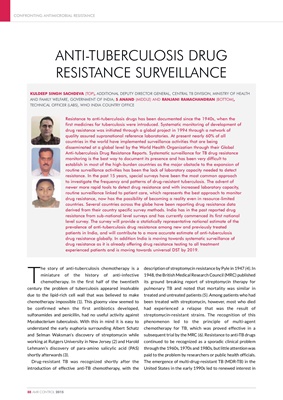
CONFRONTING ANTIMICROBIAL RESISTANCE
88 AMR CONTROL 2015
T
he story of anti-tuberculosis chemotherapy is a
miniature of the history of anti-infective
chemotherapy. In the first half of the twentieth
century the problem of tuberculosis appeared insolvable
due to the lipid-rich cell wall that was believed to make
chemotherapy impossible (1). This gloomy view seemed to
be confirmed when the first antibiotics developed,
sulfonamides and penicillin, had no useful activity against
Mycobacterium tuberculosis. With this in mind it is easy to
understand the early euphoria surrounding Albert Schatz
and Selman Waksman's discovery of streptomycin while
working at Rutgers University in New Jersey (2) and Harold
Lehmann's discovery of para-amino salicylic acid (PAS)
shortly afterwards (3).
Drug-resistant TB was recognized shortly after the
introduction of effective anti-TB chemotherapy, with the
description of streptomycin resistance by Pyle in 1947 (4). In
1948, the British Medical Research Council (MRC) published
its ground breaking report of streptomycin therapy for
pulmonary TB and noted that mortality was similar in
treated and untreated patients (5). Among patients who had
been treated with streptomycin, however, most who died
had experienced a relapse that was the result of
streptomycin-resistant strains. The recognition of this
phenomenon led to the principle of multi-agent
chemotherapy for TB, which was proved effective in a
subsequent trial by the MRC (6). Resistance to anti-TB drugs
continued to be recognized as a sporadic clinical problem
through the 1960s, 1970s and 1980s, but little attention was
paid to the problem by researchers or public health officials.
The emergence of multi-drug-resistant TB (MDR-TB) in the
United States in the early 1990s led to renewed interest in
ANTI-TUBERCULOSIS DRUG
RESISTANCE SURVEILLANCE
KULDEEP SINGH SACHDEVA (TOP), ADDITIONAL DEPUTY DIRECTOR GENERAL, CENTRAL TB DIVISION, MINISTRY OF HEALTH
AND FAMILY WELFARE, GOVERNMENT OF INDIA; S ANAND (MIDDLE) AND RANJANI RAMACHANDRAN (BOTTOM),
TECHNICAL OFFICER (LABS), WHO INDIA COUNTRY OFFICE
Resistance to anti-tuberculosis drugs has been documented since the 1940s, when the
first medicines for tuberculosis were introduced. Systematic monitoring of development of
drug resistance was initiated through a global project in 1994 through a network of
quality assured supranational reference laboratories. At present nearly 60% of all
countries in the world have implemented surveillance activities that are being
disseminated at a global level by the World Health Organization through their Global
Anti-tuberculosis Drug Resistance Reports. Systematic surveillance for TB drug resistance
monitoring is the best way to document its presence and has been very difficult to
establish in most of the high-burden countries as the major obstacle to the expansion of
routine surveillance activities has been the lack of laboratory capacity needed to detect
resistance. In the past 15 years, special surveys have been the most common approach
to investigate the frequency and patterns of drug-resistant tuberculosis. The advent of
newer more rapid tools to detect drug resistance and with increased laboratory capacity,
routine surveillance linked to patient care, which represents the best approach to monitor
drug resistance, now has the possibility of becoming a reality even in resource-limited
countries. Several countries across the globe have been reporting drug resistance data
derived from their country specific survey methods. India has in the past reported drug
resistance from sub-national level surveys and has currently commenced its first national
level survey. The survey will provide a statistically representative national estimate of the
prevalence of anti-tuberculosis drug resistance among new and previously treated
patients in India, and will contribute to a more accurate estimate of anti-tuberculosis
drug resistance globally. In addition India is moving towards systematic surveillance of
drug resistance as it is already offering drug resistance testing to all treatment
experienced patients and is moving towards universal DST by 2019.